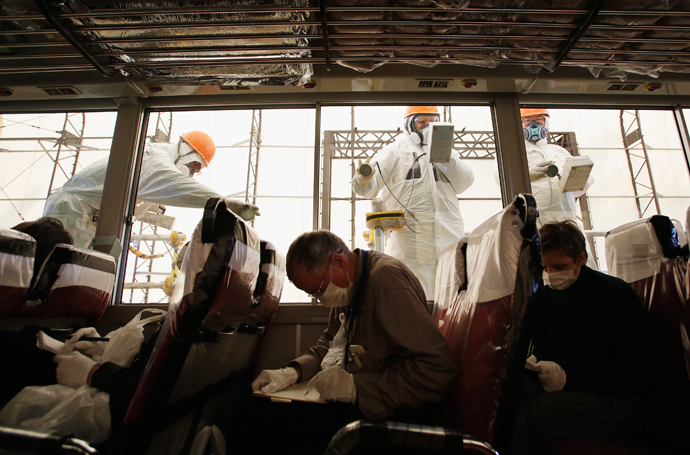TEPCO admits leakage of 300 tons of water with monstrous radiation level

An aerial view shows workers wearing protective suits and masks work at a construction site (C) of the shore barrier to stop radioactive water from leaking into the sea, at the tsunami-crippled Fukushima Daiichi nuclear power plant in Fukushima (Reuters / Kyodo)
Another tank with highly radioactive water at the devastated Fukushima nuclear power plant has leaked, reported operator TEPCO. The contaminated water contains an unprecedented 80 million Becquerels of radiation per liter. The norm is a mere 150 Bq.
A spokesman for the Tokyo Electric Power Co (TEPCO) said on Tuesday that 300 tons of highly radioactive water has leaked from a stainless steel tank on the territory of the Fukushima nuclear power plant.
Japan's Nuclear Regulation Authority has classified the leak as a Level One incident, the second lowest on the International Nuclear Event Scale (INES) for radiological releases, a spokesman informed Reuters.
The incident is the first Level One since the actual catastrophe at Fukushima in March 2011 when Japanese authorities issued an INES rating.
Level One means that the incident is classified as anomalous situation that exceeds limits of safe functioning of an installation. The most dangerous, Level Seven, has only been applied twice: for the Chernobyl catastrophe in 1986 and the meltdown of three reactors at Fukushima plant itself.
Release of radioactive energy is measured in Becquerels, i.e. radioactive decay collision events per second happening in a certain volume of material. The internationally accepted normal radioactivity level is 150 Becquerels.
According to TEPCO’s own measurements the puddle that formed around the damaged tank is emitting radiation of 100 Millisieverts per hour, as a probe has been taken about half a meter from the water, reported Kyodo News.
A dose rate measured in Sieverts indicates how much radiation a person would receive standing near the source of radiation.
A typical release of radiation is generally taken for 1 Millisievert per year, but exposure limits for the nuclear industry personnel are much higher. Still, an hour near that puddle of radioactive water is equivalent to five years of total radiation exposure – even for TEPCO staff deployed at the Fukushima site.
TEPCO has to keep the melted uranium fuel rods of three destroyed reactors awash with water using a jerry-rigged system only to keep the melted debris cool and relatively stable. To establish a closed cycle of the process, the operator stores huge amounts of radioactive water at Fukushima nuclear facility.
It is believed that overall there are more than 350,000 tons of radioactive water stored at the Fukushima plant in special tanks and the drainage system, and without special protection in the basements of the devastated facility. At the beginning of 2013, TEPCO drained most of the basement galleries, pumping radioactive water into newly delivered tanks.
TEPCO insists that since the tanks are located on elevated ground some 500 meters from the seashore, the puddle from the damaged tank has not escaped into the Pacific Ocean. Still, the level of contaminated water in the tank continues to lower, the company stated.
At the same time the ruined reactors of the Fukushima nuclear facility are located practically on the coast. And while the melted cores of the three destroyed reactors have burnt through the concrete basement of the reactor zone, radioactive water is soaking down into soil, eventually getting into the Pacific Ocean – a fact confirmed by radiation samples.
Leakage of radiation-contaminated water has been the major threat to Japan’s population and environment from the very beginning of the Fukushima disaster. But until recently TEPCO has been flatly denying that radioactive waste is escaping into the Pacific.
Only in late July the company acknowledged the fact that contaminated water is escaping from basements and trenches of the Fukushima plant into the ocean.
Japanese authorities have demanded that TEPCO take immediate measures to stop radioactive leakage into the ocean.
After Fukushima disaster practically all Japanese nuclear power plants were taken out of service for safety checks. So far only two out of total 50 Japanese nuclear power plants have returned to service.


No comments:
Post a Comment